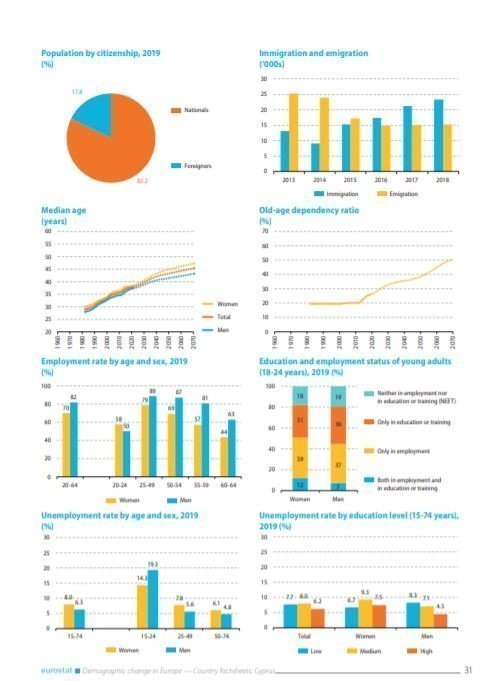in-cyprus 17 June 2020 -Bouli Hadjioannou


The population of Cyprus stands at 900,000, or 0.2% of the EU 27 total, the population density is 94 per square kilometre, the household disposable income per capita is 88% of the EU 27 average and consumption per capita is 96% of the EU 27 average.
These are some of the figures contained in the factsheet for Cyprus that was published on Wednesday as part of European Commission’s ‘Report on the impact of demographic change‘ .
The report presents the drivers of demographic change and the impact they are having across the European Union.
Regarding the population structure, the report projects that the 20 to 39 age group will shrink by 10% to 15% by 2070 while the age of groups from 60 to 80+ will rise by 25% to 30%.
Overall, the population is projected to total 1.1 million in 2070, but as a results in the number of people aged 65 to 80+.
In 2070, deaths are expected to marginally exceed births and the total fertility rate will remain close to or below 1.5.
Life expectancy at birth in Cyprus in 2070 will be 86 for men and 90 for women. Life expectancy and healthy life years in 2018 were 82.9 and 62.2 respectively (84.8 and 62.4 for women and 80.9 and 62 for women).


The report helps identifying how the people, regions and communities most affected can best be supported to adapt to changing realities.
On the basis of this report, the European Commission will engage in a dialogue with relevant stakeholders, in particular at regional level, and discuss with Member States, EU institutions and bodies, notably the European Economic and Social Committee and the Committee of the Regions.
With this in mind, and using the findings in this report as a starting point, the Commission will put forward a Green Paper on ‘Ageing and a Long-term vision for Rural Areas‘. This report also shows the need to embed demographic considerations across its policies. You can read more on this on the dedicated page of the European Commission.
The findings of the report show that there is no one-size-fits-all approach. Policymaking needs to zoom into the reality on the ground. The European Union, Member States and regions have a shared interest in responding to demographic change for the benefit of all Europeans.
The Staff Working Document supplements the ‘Report on the impact of demographic change‘ with more detail statistical information. Readers interested in digging a little bit more into the statistical data find there an ample collection of figures, maps and tables accompanied by brief descriptions.
Furthermore, complementing the report, Eurostat provides a set of country factsheets on the 27 Member States. Drawing on statistics produced by Eurostat, the factsheets present a carefully chosen selection of demographic and social statistics allowing the first glimpse at individual Member State demographic figures.
